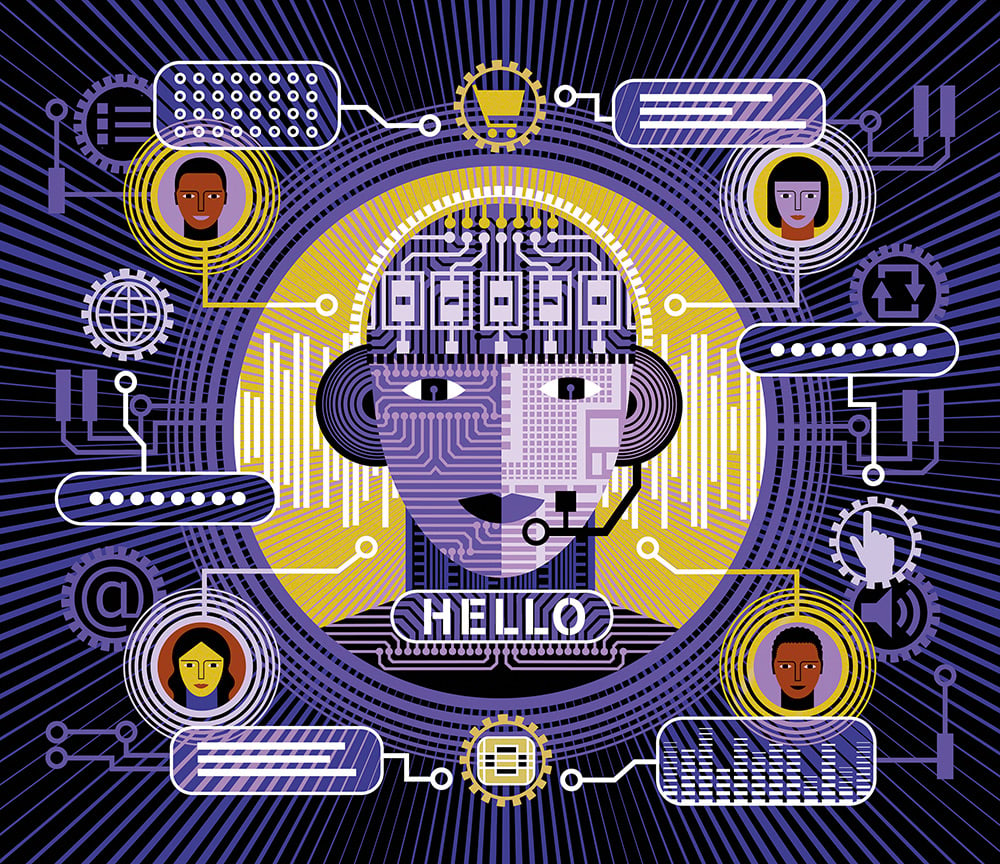Why technical leaders have the advantage in the AI era
Tom Slater – Manager, Scottish Mortgage Investment Trust
- Bosses with technical expertise are often quick to deploy new technologies that benefit their business
- We see this dynamic at play with generative AI at Meta, Shopify, Roblox and Spotify
- By learning from such trailblazers, Scottish Mortgage improves its ability to spot further investment opportunities

Please remember that the value of an investment can fall and you may not get back the amount invested.
In combat, the US Air Force follows a protocol called the OODA loop: observe, orient, decide and act. Experience shows that agile pilots who cycle through it quickest are more likely to win dogfights.
The process also applies to business. We’ve observed that ‘technical leaders’ often gain the upper hand when stakes are high precisely because their expertise helps them speed through the loop to outmanoeuvre the competition. These chief executives don’t need to write and test software or configure datacentres themselves but do require a deep understanding of the technologies and complexities involved.
We live in a world of exponential technological progress, where companies constantly have to adapt to innovations. But the pace of evolution isn’t constant. Sometimes, there are periods of relative stability.
Take the 2010s. We knew the main parts of the technology stack – the internet, mobile communication, satellite navigation, etc – and the challenge was to find novel, effective uses for them.
However, artificial intelligence means the 2020s might be more like the preceding period when many of those foundational technologies were still being established, and computer capabilities were in flux. At times like these, you want a leader who doesn’t need consultants to tell them what a developing technology can and can’t do and who can spot how their business can best exploit it to move quickly and gain a first-mover advantage.
So, as an investor in exceptional growth, Scottish Mortgage aims to own a selection of companies led by technical leaders that have plenty of potential AI applications. This led us to reinvest in Meta last year.
Zuckerberg’s conviction
Founder Mark Zuckerberg’s credentials hardly need rehashing. Ever since coding the original version of Facebook in his Harvard University dorm room, he has repeatedly demonstrated an ability to turn emerging technologies into practical products at speed.
“Some of the most rewarding work involves getting deep into the details of technical projects,” he wrote years later, after building an AI system as a personal challenge to identify visitors to his home and entertain his daughter.
To illustrate how Zuckerberg’s deep knowledge can pay off, consider his outsized purchase of NVIDIA’s top-of-the-range H100 AI chips in 2022. Meta needed extra processing power to improve its Reels short video recommendations to catch up with ByteDance’s TikTok. Rather than simply buying enough chips to achieve this, Zuckerberg doubled the order. He foresaw that Meta would soon need extra capacity, even though he didn’t yet know what for.
This aggressive investment in infrastructure was a non-obvious use of capital at the time. But it paid off. When OpenAI revealed its ChatGPT chatbot, others rushed to buy H100s, constraining supply and causing a price spike. However, Meta was able to develop its generative AI large language model (LLM) Llama and the services it powers more quickly and cheaply than it could have done otherwise.
When we owned Meta in the past, we recognised Zuckerberg’s ability to allocate capital as a strength, as demonstrated by his acquisition of Instagram and WhatsApp. He saw the potential in these assets long before others. However, we sold over concerns that regulators would prevent further takeovers of this scale. What’s now changed is that AI gives Zuckerberg new ways to exploit his skill at spending on the right things.
Meta has many ways to profit from Llama. It has already made its platforms more attractive to advertisers by letting them automatically generate text tailored to their brands and adjust images to suit whether they appear on Facebook Stories, Instagram’s Explore grid, third-party apps or elsewhere.
Even more promising is Meta’s use of Llama to power chatbots for businesses. The AI agents can handle customer queries, take bookings and make sales on Messenger and WhatsApp. About three billion people use one or both of these chat apps, but historically their revenues have been meagre. Now, there’s a massive opportunity to make money.
Intriguingly, Meta has made Llama open source, meaning others can access, modify and distribute it for free. That’s in stark contrast to OpenAI, Google and others that lock their code away and charge a fee for access to their models to recoup some of the billions of dollars of training costs.
Zuckerberg’s insight is that by making Llama free for others to use on their own hardware, the wider development community will help find ways to reduce its running costs, which might be more valuable to Meta in the long run. Furthermore, he undermines his competitors’ business models in the process.
Shopify’s AI shift
Shopify is another portfolio company benefiting from technical leadership. Chief executive Tobi Lütke taught himself how to program in BASIC on an Amstrad computer in the 1990s and continues to find inspiration in learning computer languages. In fact, he credits one – Nix and its focus on reproducibility – with directly influencing a human resources shake-up that led Shopify to become more consistent and efficient at allocating staff to projects.
Lütke has also applied his engineer’s mindset to Shopify’s core offering: software to help merchants sell goods online. The company initially focused on providing smaller businesses with a complete solution. But over the past decade, it has also targeted larger, more lucrative enterprise customers. These clients tend to want more customisation.
So the firm launched Shopify Plus, which offers functions such as product search and shopping carts as individual modules. And more recently, it added Shopify Functions, which lets merchants override the software’s default behaviours by adding their own code.
Shopify could only achieve this because, in 2016, Lütke decided to shift its service’s underlying architecture from a monolithic, highly interconnected model, in which even a small change to the system could cause a cascade of problems, to a component-based design. This meant each part would have its own boundary and be developed and maintained independently.
His critical insight was that your architecture defines the range of business strategies you can pursue.
Today, Shopify is at another turning point. Lütke has told staff that AI will lead to a “decade of high velocity and massive change” and should become their focus.

Early efforts include Sidekick, a chatbot assistant that makes it easy for merchants to use natural-language requests to run their stores, such as by offering sale discounts or altering which products have prominence. In addition, Shopify is making things easier for customers with better-informed search results, recognising, for example, that a request for ‘Christmas-themed shoes’ should surface red-and-green footwear.
It’s not yet clear how AI will reshape commerce. Perhaps virtual agents will eventually anticipate our needs and negotiate prices for us. However, having a technical leader gives Shopify the best chance of strategic flexibility in the future.
Roblox chats
Generative AI is also reshaping what’s possible at Roblox. Its chief executive, David Baszucki, began his career by writing a popular 2D physics simulator for the Macintosh computer in the 1980s. Its success inspired him to develop a 3D follow-up that took advantage of the cloud and people’s ability to play together, which became the video game platform.
One of the company’s fundamental strengths has been Baszucki’s unwavering focus on what’s important to Roblox’s audience. For example, the firm has prioritised making creators’ games run without lag when many players are interacting rather than trying to provide photorealistic graphics or more video frames per second.
The firm is taking a similar pragmatic approach to AI. For example, in February it began using an LLM to automatically translate chats in real time between players conversing in any of 16 supported languages. It has also developed tools that suggest code to game developers and help them design characters and other virtual items.
These steps magnify the experiences creators can deliver on Roblox, encouraging players to spend more time and money on the platform. However, the firm has avoided using the most powerful AI models, as processing each query would have been cost-prohibitive.
Instead, it has contributed to more economical open-source alternatives based on Baszucki’s understanding that Roblox’s competitive advantage lies in the wealth of proprietary data to which it can apply those models.
Spotify and artificial artists
Spotify’s founder, Daniel Ek, is a fourth example of a technical leader and the one who introduced me to ChatGPT. He was gripped from the start, becoming one of the first to license OpenAI’s technology to power Spotify’s AI DJ, which entertains subscribers between tracks.
Generative AI is likely to lead to an explosion in new material on the audio platform. It will make it easier to remix existing songs and create new ones. Entirely manufactured artists may even become commonplace. The ramifications are also huge for the podcasts and audiobooks Spotify hosts.
One of Spotify’s challenges has been agreeing on how much the record labels and creators earn from each streamed song. How will that change in a world of AI content? How will the service’s algorithms account for different subscribers’ perceptions of the material? And how will Spotify avoid becoming oversaturated with artificial artists?
These are unanswered questions. However, having somebody who deeply understands the technology and is agile in decision-making is invaluable when navigating a rapidly changing environment.
Scottish Mortgage, too, must keep cycling through the OODA loop to observe, orient, decide and act regarding how artificial intelligence affects our portfolio. But, as discussed, that goes far beyond thinking about the technology.
The coming changes will play out over many years, and we will gain our edge from broad exposure to smart, adaptable leaders from whom we can learn. In the AI age, partnering with such entrepreneurs has never been more critical.

About the author - Tom Slater
Manager, Scottish Mortgage Investment Trust
Tom Slater is manager of Scottish Mortgage Investment Trust and head of Baillie Gifford's US Equities Team. Tom's focus is on high-growth companies.
Regulatory Information
This content was produced and approved at the time stated and may not have been updated subsequently. It represents views held at the time of production and may not reflect current thinking. Read our Legal and regulatory information for further details.
A Key Information Document is available by visiting our Documents page. Any images used in this content are for illustrative purposes only.
This content does not constitute, and is not subject to the protections afforded to, independent research. Baillie Gifford and its staff may have dealt in the investments concerned. The views expressed are not statements of fact and should not be considered as advice or a recommendation to buy, sell or hold a particular investment.
Baillie Gifford & Co and Baillie Gifford & Co Limited are authorised and regulated by the Financial Conduct Authority (FCA). The investment trusts managed by Baillie Gifford & Co Limited are listed on the London Stock Exchange and are not authorised or regulated by the FCA.
Baillie Gifford Asia (Hong Kong) Limited 柏基亞洲(香港)有限公司 (BGA) holds a Type 1 licence from the Securities and Futures Commission of Hong Kong to market and distribute Baillie Gifford’s range of collective investment schemes and closed-ended funds such as investment trusts to professional investors in Hong Kong.
Baillie Gifford Asia (Singapore) Private Limited (BGAS) is regulated by the Monetary Authority of Singapore as a holder of a capital markets services licence to conduct fund management activities for institutional investors and accredited investors in Singapore. BGA and BGAS are wholly owned subsidiaries of Baillie Gifford Overseas Limited, which is wholly owned by Baillie Gifford & Co.
Europe
Scottish Mortgage Investment Trust PLC (the “Company”) is an alternative investment fund for the purpose of Directive 2011/61/EU (the “AIFM Directive”). Baillie Gifford & Co Limited is the alternative investment fund manager (“AIFM”) of the Company and has been authorised for marketing to Professional Investors in this jurisdiction.
This content is made available by Baillie Gifford Investment Management (Europe) Limited (“BGE”), which has been engaged by the AIFM to carry out promotional activities relating to the Company. BGE is authorised by the Central Bank of Ireland as an AIFM under the AIFM Regulations and as a UCITS management company under the UCITS Regulation. BGE also has regulatory permissions to perform promotional, advisory and Individual Portfolio Management activities. BGE has passported its authorisations under the mechanisms set out in the AIFM Directive.
Belgium
The Company has not been and will not be registered with the Belgian Financial Services and Markets Authority (Autoriteit voor Financiële Diensten en Markten / Autorité des services et marchés financiers) (the FSMA) as a public foreign alternative collective investment scheme under Article 259 of the Belgian Law of 19 April 2014 on alternative collective investment institutions and their managers (the Law of 19 April 2014). The shares in the Company will be marketed in Belgium to professional investors within the meaning the Law of 19 April 2014 only. Any offering material relating to the offering has not been, and will not be, approved by the FSMA pursuant to the Belgian laws and regulations applicable to the public offering of securities. Accordingly, this offering as well as any documents and materials relating to the offering may not be advertised, offered or distributed in any other way, directly or indirectly, to any other person located and/or resident in Belgium other than to professional investors within the meaning the Law of 19 April 2014 and in circumstances which do not constitute an offer to the public pursuant to the Law of 19 April 2014. The shares offered by the Company shall not, whether directly or indirectly, be marketed, offered, sold, transferred or delivered in Belgium to any individual or legal entity other than to professional investors within the meaning the Law of 19 April 2014 or than to investors having a minimum investment of at least EUR 250,000 per investor.
Germany
The Trust has not offered or placed and will not offer or place or sell, directly or indirectly, units/shares to retail investors or semi-professional investors in Germany, i.e. investors which do not qualify as professional investors as defined in sec. 1 (19) no. 32 German Investment Code (Kapitalanlagegesetzbuch – KAGB) and has not distributed and will not distribute or cause to be distributed to such retail or semi-professional investor in Germany, this document or any other offering material relating to the units/shares of the Trust and that such offers, placements, sales and distributions have been and will be made in Germany only to professional investors within the meaning of sec. 1 (19) no. 32 German Investment Code (Kapitalanlagegesetzbuch – KAGB).
Luxembourg
Units/shares/interests of the Trust may only be offered or sold in the Grand Duchy of Luxembourg (Luxembourg) to professional investors within the meaning of Luxembourg act by the act of 12 July 2013 on alternative investment fund managers (the AIFM Act). This document does not constitute an offer, an invitation or a solicitation for any investment or subscription for the units/shares/interests of the Trust by retail investors in Luxembourg. Any person who is in possession of this document is hereby notified that no action has or will be taken that would allow a direct or indirect offering or placement of the units/shares/interests of the Trust to retail investors in Luxembourg.
Switzerland
The Trust has not been approved by the Swiss Financial Market Supervisory Authority (“FINMA”) for offering to non-qualified investors pursuant to Art. 120 para. 1 of the Swiss Federal Act on Collective Investment Schemes of 23 June 2006, as amended (“CISA”). Accordingly, the interests in the Trust may only be offered or advertised, and this document may only be made available, in Switzerland to qualified investors within the meaning of CISA. Investors in the Trust do not benefit from the specific investor protection provided by CISA and the supervision by the FINMA in connection with the approval for offering.
Singapore
This content has not been registered as a prospectus with the Monetary Authority of Singapore. Accordingly, this content and any other content or material in connection with the offer or sale, or invitation for subscription or purchase, of the Trust may not be circulated or distributed, nor may be offered or sold, or be made the subject of an invitation for subscription or purchase, whether directly or indirectly, to persons in Singapore other than (i) to an institutional investor (as defined in Section 4A of the Securities and Futures Act 2001, as modified or amended from time to time (SFA)) pursuant to Section 274 of the SFA, (ii) to a relevant person (as defined in Section 275(2) of the SFA) pursuant to Section 275(1), or any person pursuant to Section 275(1A), and in accordance with the conditions specified in Section 275 of the SFA, or (iii) otherwise pursuant to, and in accordance with the conditions of, any other applicable provision of the SFA.
Where the Trust is subscribed or purchased under Section 275 by a relevant person which is:
(a) a corporation (which is not an accredited investor (as defined in Section 4A of the SFA)) the sole business of which is to hold investments and the entire share capital of which is owned by one or more individuals, each of whom is an accredited investor; or
(b) a trust (where the trustee is not an accredited investor) whose sole purpose is to hold investments and each beneficiary of the trust is an individual who is an accredited investor, securities or securities-based derivatives contracts (each term as defined in Section 2(1) of the SFA) of that corporation or the beneficiaries’ rights and interest (howsoever described) in that trust shall not be transferred within six months after that corporation or that trust has acquired the securities pursuant to an offer made under Section 275 except:
(1) to an institutional investor or to a relevant person or to any person arising from an offer referred to in Section 275(1A) or Section 276(4)(c)(ii) of the SFA,
(2) where no consideration is or will be given for the transfer;
(3) where the transfer is by operation of law; or
(4) pursuant to Section 276(7) of the SFA or Regulation 37A of the Securities and Futures (Offers of Investments) (Securities and Securities-based Derivatives Contracts) Regulations 2018.







